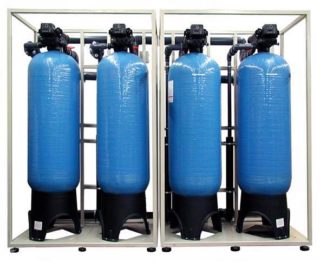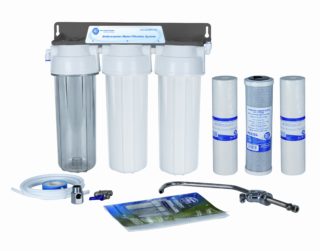The results of many studies in laboratory conditions show that the quality of tap water does not meet the established standards. To prevent the development of diseases and extend the life of household appliances and plumbing fixtures, it is recommended to clean and soften the liquid. Often, tap water contains a high concentration of metals and salts, which negatively affect the human body. To solve the problem, it is recommended to install ion exchange filters in private houses or apartments.
Purpose and scope of ion-exchange filters for water purification

The most popular and affordable way to purify and soften tap water is the use of ion exchange filters. The method allows not only to extract, but also to retain harmful impurities.
Used in everyday life and on an industrial scale. Without the participation of ion exchange, production in the food industry, thermal and nuclear power, non-ferrous metallurgy, wastewater treatment and the electronics industry will be suspended. Over the past 5 years, work has been constantly underway to extract valuable components from the ocean depths.
Regular inspections can identify problems or prevent their formation. In emergency situations, it is required to close the valves before and after the filtering equipment, and also turn off the power supply. If you cannot fix the breakdown on your own, it is better to contact the service center.
Device and principle of operation

Ion filters for household use consist of a body, a cartridge impregnated with ion exchange resin, distribution devices, pipelines and a reservoir for purified water. High quality materials are used in the production, for example, steel or durable food grade plastic.
The central part of the body is equipped with a filtration unit made of ion-exchange fiber. Behind it there is a mesh filter that traps harmful impurities in tap water, and an ion exchanger. The task of the last working unit is to replace the ions of salts, potassium and iron with hydrogen or sodium. The housing has special outlet openings for removing gases dissolved in the liquid to the outside.
There are different modifications of filters with different performance and power, which directly depend on the direction of the regenerating flow and the filtering load. The dimensions of the models also depend on the operating conditions and purpose.
It is recommended to install ion exchange filters if the mineralization of tap water reaches 100 mg of salts / 1 liter.
Devices with hydrogen resins are considered to be the most effective. Passing through such a filter, radioactive substances and heavy metals are captured and converted into safe hydrogen. As a result of this process, a change in the acid-base balance of water is carried out.
Resins are inorganic substances containing a large number of pores. Available in the form of granules.
Features of operation and maintenance

To extend the service life of the purification filter, you must not only correctly install and configure it, but also regularly take preventive measures.An integral part of maintenance is timely and regular replenishment of regeneration salts and resins. If there is a shortage of an active component, the entire cleaning system will not be able to work properly, and the resins will quickly become unusable.
Ion-exchange filters are often installed in country houses and dachas with an autonomous water supply system, where there is no centralized disinfection. To prevent infection of water by pathogens, you need to use high-quality disinfecting chemicals.
It is also important to remember to properly dispose of waste.
Advantages and disadvantages
Ion-exchange water purification filters, like other analogs, have not only advantages, but also disadvantages. More about the advantages:
- Easy to install, use and maintain.
- High quality tap water purification and softening.
- The composition reduces the amount of salts and other harmful impurities.
Among the disadvantages are the following:
- Low rates of resin hydrophilicity.
- Tangible financial costs for the recovery of chemical reagents.
All the shortcomings in modern models are almost imperceptible, since the consumption of valuable resins is slow, and special catalysts make the process of purification and softening as efficient as possible.








